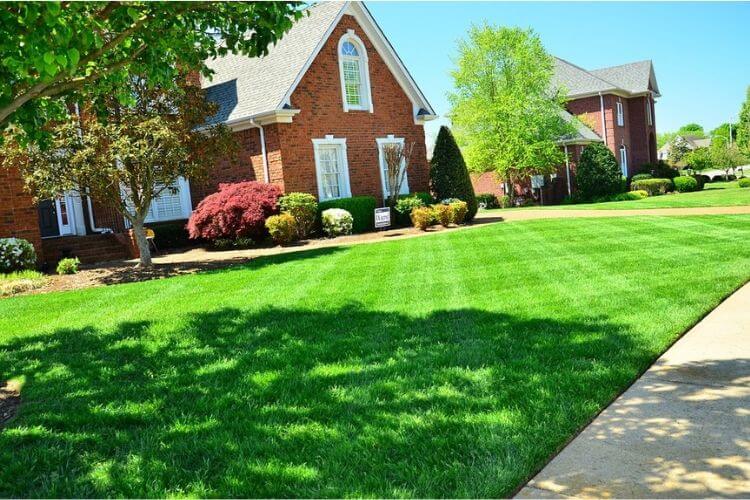By J. Herwick
We use affiliate links and may receive a small commission on purchases.
Read more about us.
If you’ve ever thought about using portable fire pits on grass, you’ve most likely fretted about the damage it might do to your lawn and the surrounding area, i.e. scorch marks, and wilting due to intense heat stress, compression, etc.
These are all valid and pretty common concerns, considering fire pits give off temperatures from 1,200 degrees (hat tip to Sciencing.com for the bonfire temperature stat).
Heat at that level, in such proximity, can really do a number on your lawn if you don’t take the proper precautions.
I’ve personally felt the regret of doing this on the fly and hoping for the best. Depending on the damage, it may take some manual labor (and expense) on your part and weeks, or even longer, for your grass to recover. Don’t be that guy (or girl).
If you want to use fire pits on grass, there’s no need to worry or rule it out as a backyard surface option. There are a lot of workarounds that will help you protect the appearance and health of your lawn if decide to go that route.
Just a quick point for this article; we are specifically referring to portable backyard fire pits, not fixed stone masonry fire pits, and their use.
There are a wide variety of do-it-yourself (DIY) and store-bought options for protecting heat-vulnerable surfaces on your property, such as grass, when using a fire pit. Pavers placed in a grid configuration, can provide an inexpensive, but robust, temporary barrier between your fire pit and your grass.
There are a variety of commercially available heat-resistant steel, rubber, and fabric options, specifically designed for use with fire pits, and other common outdoor items such as barbecue grills and smokers, that generate high temperatures
If you are like me, you spend a lot of time trying to keep your yard looking good against all odds.
The neighbor’s dog, despite the constraints of an invisible fence, seems to find a way to pee on my grass, out-of-control weeds, spots where grass won’t grow, my kids and their friends tearing up the grass, lack of rain, etc…etc…ad nauseum.
The truth is, I can’t get my grass to look like I want it to as it is, so crossing my fingers and hoping the old fire pit won’t leave a nice scorch mark is definitely a no go.
I don’t need another blemish on my lawn to fix that will take till the end of summer to look semi-normal again.

Fire Pits and Grass Heat Stress
Every lawn is exposed in some form or another to a variety of conditions that are not good for it. Heat stress, in particular, is a big contributor to grass problems that are both cosmetic and bad for the long-term health of your lawn.
Heat stress is typically a result of hot dry conditions common in summer and weakens your lawn’s ability to thrive by crowding out weeds and resisting damage brought on by insects and disease.
Fire pits on grass can add to or create these conditions in a particular section of your lawn if you don’t take precautions to protect grass from direct heat and the lack of moisture around the fire pit itself.
Ghost prints (grass not recovering quickly from pressure) and discoloration are common end results of excessive heat stress.
Shielding your lawn properly from direct heat and ensuring hydration while using fire pits on grass can help the area recover quickly after use.
Protection When Using Fire Pits on Grass
When using fire pits on grass, remember to look around and assess your immediate surroundings and make sure there is enough distance between you and nearby structures, trees, and anything else you don’t want to see catch on fire.
20 to 25 feet (7.62 m) for structures such as your home, shed, stacked wood, etc. 10 to 15 feet (4.57 m) from tree branches if you choose a spot near trees.
Also, make sure the spot you pick for your fire pit is level. You don’t want to risk tip-over if your fire pit is accidentally knocked over or off the fire pit grass protector/barrier for any reason.
At worst, your guests won’t like burning embers flying into their laps; at best, your efforts to protect your lawn will have been for nothing.
Once you have decided on a level spot, with adequate spacing from structures and trees, you can start setting everything up.
Begin by positioning your barrier (pavers or store-bought heat barriers) you can now rest your fire pit on the barrier, making sure it is level and centered, with all fire pit legs in contact with the barrier.
Safety Pro Tip: When choosing a barrier, make sure to have adequate space between the fire pit’s supports (or legs) and the edge of the barrier after centering. I try for at least a 6-12 inch deep perimeter around the legs/supports. Without this space, the fire pit could fall off the barrier and tip over if inadvertently bumped by anyone.
Before lighting your fire pit, mist the grass on the entire perimeter of the fire pit with water to minimize heat stress on the surrounding grass. Keep a hose or a bucket of water nearby for additional applications as the water evaporates.
Don’t go crazy with the water by applying too much. You don’t want to create a slipping hazard on the grass.
Once the party is over, the fire is out, and the embers have completely cooled, transfer the remaining contents of the fire pit to an ash bucket or similar metal container of your choice for disposal.
Remove the completely cooled fire pit (with assistance as necessary) from your fire pit grass protector, then remove the protective barrier from your lawn. This is particularly important when using pavers.
The compression, lack of light, airflow, etc. will kill the grass if the pavers are left down too long. Remove them as soon as you are able.

Safety Tips When Using Fire Pits On Grass
Please use the tips below not only when using a fire pit on grass but in every situation where there is a fire pit. You’ll see a tailored variation of these in all of my safety-related articles but the message is always the same:
- Never leave any fire pit unattended
- Maintain very close supervision of children and pets in the vicinity of fire pits; this is particularly important in grassed areas as children are often playing on this surface and will most likely be doing so nearby
- Moderate your personal alcohol consumption when operating a fire pit; everyone’s safety depends on you being alert and sober enough to take proper action if and when the situation dictates
- Have a water hose, water bucket, or fire extinguisher within arm’s reach of your location near a fire pit
- For wood-burning fire pits: do not use lighter fluid, gasoline, or any other petroleum-based fuel to start a fire in a fire pit; consider using a fire pit screen to contain sparks
- Utilize log grabbers to add and reposition logs in fire pits
- When done using the fire pit, extinguish the fire with water and stir contents until ash is saturated; sand is an option as well for putting out the fire
Check out my article, Fire Pit Safety 101: A Primer, for more on the topic of backyard safety.
Conclusion: Fire Pits on Grass
There’s no reason you can’t use your portable fire pit on grass if you take the time and necessary precautions to avoid unsightly and potentially costly damage. At the basic level, the steps are simple and the tools to get it done are relatively inexpensive and easily accessible.
Safety trumps convenience every time; please make sure the spot you select and the way you set everything up are driven with this in mind.
Finally, if you are interested in some solid gas fire pit options that are a little more lawn-friendly than a typical wood-burning fire pit, check out my article Best Portable Propane Fire Pit for Patios, RVs, and More for my top pick and 2 other strong candidates.
I still recommend using a fire pit heat shield if you go this route, but it doesn’t have to be as robust as one you would use for a wood-burning fire pit.
Thanks for reading and take care!
John
Related Questions
Why put sand at the bottom of a fire pit?
First, due to the potential for injury when using a fire pit, it’s always best to consult the owner’s manual of the fire pit in question with regard to operation and maintenance.
The main purpose of adding sand to the bottom of a fire pit is to aid in heat distribution, but it also provides a shield of sorts between the fire and the metal bowl helping to slow deterioration due to regular high heat exposure.
This can also be accomplished with the use of commercially available fire brick or lava rocks.
An additional benefit in my opinion of adding sand (or rock) is the stability provided to the fire pit by the extra weight.
Sand or rock evenly distributed at the bottom of the fire pit can aid in minimizing tip-overs, particularly on soft non-masonry surfaces like grass.
How do I protect my grass from sparks or other debris expelled from a fire pit?
The best way to protect your grass (and your guests) from fire pit sparks, debris, etc. is to make sure they don’t come into contact with each other.
This can be accomplished by using a spark screen, which can be constructed at home with relatively inexpensive materials or purchased commercially.
A spark screen is essentially a framed wire mesh dome barrier that is placed on top of the fire pit opening. Most have handles for easy placement and removal from the fire pit.
The spark screen typically rests on top of the fire pit, not attached in any way.
How can I help my grass recover after I have removed the fire pit and protective barrier from my lawn?
It’s no secret your grass takes a beating during fire pit use; from the heat generated, the compression of the grass from the weight of your protective barrier, the higher-than-usual foot traffic, and the damage done by the seating used.
In most cases, the following will help your grass recover after a fire pit party:
- Cordon the area off if you have to, but no foot traffic until the lawn area is back to normal
- Use a leaf blower to fluff up the matted spots in the lawn and get air flowing through the blades of grass; a gentle raking can accomplish this as well
- Cultivate and apply seed to areas that sustained damage due to foot traffic or other factors
- Keep the area adequately hydrated to speed recovery
Interested in more fire pit safety accessory ideas? Check out my big list of 25 “Gotta-Have” Fire Pit Accessories for Your Next Backyard Burn.
